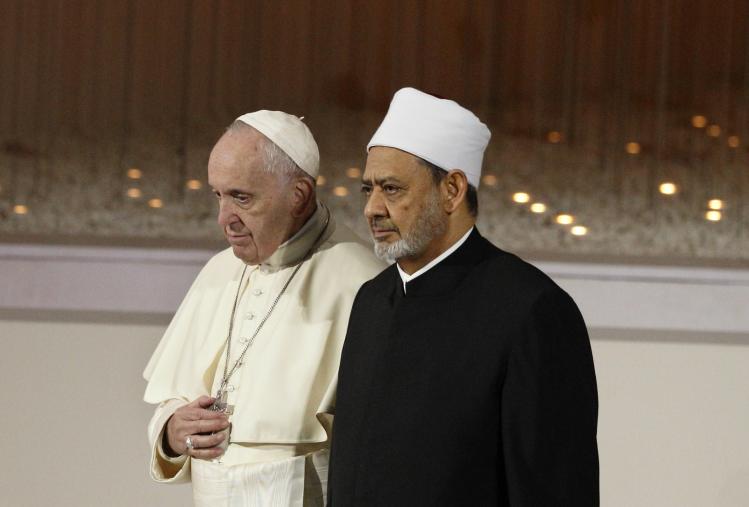
It is not a coincidence that just a few days after the return of Pope Francis from Abu Dhabi, Cardinal Gerhard Müller, the former prefect of the Congregation for the Doctrine of the Faith, whose five-term appointment the pope did not renew in July 2017, published his “Manifesto of Faith.” This document was a veiled attack on the pope, even though it did not name him. The doubts some cardinals continue to raise about the pope’s orthodoxy are, among other things, a sign that this pontificate’s basic trajectory remains the same, despite the sex-abuse crisis. One year after his eye-opening visit to Chile and Peru in January 2018, Francis has dealt with the abuse crisis by convening an unprecedented meeting of all the presidents of bishops’ conferences at the Vatican. Yet the pope has not given up on his other priorities, one of which is to improve the church’s relations with Islam and the Arab world. Francis’s February trip to the United Arab Emirates was a sign that he remains committed to this project. It was not the first such trip (in 2017 he went to Cairo for a peace conference at al-Azhar); nor will it be the last (this month he is traveling to Morocco).
The visit to the UAE was controversial within the Vatican: top curial officials wondered whether it would have been better for Francis to go to Qatar and Oman—or to Bahrain, whose sovereign invited the pope four years ago. Francis chose the UAE because he wanted to continue his dialogue with the Grand Imam of al-Azhar, the Egyptian Ahmed el-Tayeb, who organized the interreligious meeting in Abu Dhabi. The meeting was sponsored by the Abu Dhabi–based international Muslim Council of Elders and was promoted as a key part of the UAE’s “Year of Tolerance.” (In 2016 the prime minister of the UAE, Sheikh Mohammed bin Rashid Al Maktoum, announced the creation of a “minister for happiness” and a “minister for tolerance.”)
Francis may have also wanted to give greater visibility to the significant Catholic population in the UAE—close to one million—almost all of them migrant laborers from Asia. Their situation is better than that of religious minorities in some other Arab- and Muslim-majority countries, but it is nevertheless precarious. The religious tolerance they enjoy is still quite limited by Western standards. In planning his papal visits, Francis has always given special attention to countries where Catholics and Christians are a small minority. On the Arabian Peninsula, Roman Catholics live as a minority in the cradle of Islam. They are also a minority within a minority: Catholics of the Roman rite are just one of the many ancient Christian communities. Francis’s trip to the UAE served to highlight the diversity of Christian traditions in the Middle East, some of which go back to the first centuries of the church.
Francis’s trip to the Emirates was significant for three reasons. The first has to do with politics. In visiting the UAE, Pope Francis gave new visibility not only to the Christians there but also to the political initiatives of the government, which, despite its reforms, is hardly an emblem of liberal democracy. The emir of Abu Dhabi appoints the prime minister, who consults with a federal council of forty members. Legislation is based on sharia, which prescribes the death penalty for various crimes. Foreign-born residents make up more than 80 percent of the population, but their basic human rights are very often not respected. There was a high risk that the pope’s visit would be manipulated by the UAE government to contrast its relatively tolerant version of Islam with that of some of its neighbors. But that contrast can be misleading, especially in the West. The UAE spends a huge amount of its budget on weapon systems and, together with Saudi Arabia, funds the brutal war against the Houthis in Yemen.
But it would be a mistake to understand Francis’s visit as an endorsement of the regime. Under Francis, the Vatican has been reaching out to countries throughout the Arab world, including some with even more dubious human-rights records. In 2018, just a few weeks before his death in a U.S. hospital, Francis’s point man for the dialogue with the Muslim and Arab world, the French cardinal Jean-Louis Tauran, traveled to Riyadh in Saudi Arabia. There he met with King Salman— it was the first meeting between a Saudi ruler and a Catholic official. But this was just the latest in a series of meetings between senior Saudi officials and representatives of the Catholic Church, and none of them implied a Vatican endorsement of the Saudi regime. The pope is not naïve, and he made his position on the war in Yemen quite clear. In fact, just before leaving the Vatican for his flight to the Emirates, he pleaded in the Angelus prayer in St. Peter’s Square for an end to that war, fully aware of the UAE’s involvement. Francis has always been willing to talk with anyone willing to talk, including political leaders with dirty hands. It is part of his global engagement, from Raúl Castro in Cuba to Aung San Suu Kyi in Myanmar.
But of course the trip’s main significance was religious. It marked a new stage in the church’s relations with Islam. Francis’s trips to Morocco and the UAE—roughly opposite geographical ends of the Arab-speaking Muslim world—took place during the eight-hundredth anniversary of the meeting between St. Francis and the Sultan. These visits are part of an ongoing effort at improving interreligious relations that began with Vatican II. As Francis pointed out during an in-flight press conference, the Document on Human Fraternity that he and Ahmed el-Tayeb signed is perfectly in keeping with conciliar teaching: “From the Catholic point of view, the document does not pull away one millimeter from Vatican II, which is even cited a few times. The document was made in the spirit of Vatican II.”
Insofar as there’s a difference between Pope Francis and his predecessors on this issue, it’s his emphasis on fraternity: but this too can be traced back to Vatican II. While the word “dialogue” represents something like an instrument of interreligious relations, the whole intuition of Vatican II, from the moment John XXIII announced it in 1959 to the declaration Nostra aetate, which was approved in the final few weeks of the council in 1965, was about the fraternity of the one human family. In a technical sense, Pope Francis has never engaged in theological discussions that advance interreligious dialogue, where there have been few breakthroughs in recent years. Instead he has concentrated on underscoring the values that members of other religious communities share with Christians.
The Al-Azhar is one of the most prestigious theological institutions in Sunni Islam, but it would be a mistake to regard it as the Vatican of Islam. Imam el-Tayeb is both a conservative and a reformer, distrusted by both hardcore traditionalist Muslims and progressives. He is an opponent of the Muslim Brotherhood. He has spoken very harshly about Israel. He has rejected terrorism, and went to pay his respects to the victims of the 2015 massacre at the Bataclan in Paris. Francis’s relationship with el-Tayeb could become a source of division between Muslims, and even between Sunnis. But for now at least, el-Tayeb is considered the best Muslim interlocutor for Francis.
Finally, Francis’s trip to the UAE has a theological significance within the Catholic Church itself. The Document on Human Fraternity signed by Francis and el-Tayeb in Abu Dhabi has raised new concerns among those already suspicious of this pope’s orthodoxy. In a still largely Ratzingerian church, where theological clarity is understood to require a rejection of any appearance of compromise, a joint document cosigned by the Grand Imam of al-Azhar was bound to cause controversy. But compared to the February 2016 joint statement signed by Francis and the patriarch of Moscow in Cuba, the Document on Human Fraternity shows its roots in the Roman Catholic tradition quite clearly, and it is at least as challenging to Muslims as it is to Catholics. Echoing the second paragraph of Nostra aetate, the document states that “the pluralism and the diversity of religions, color, sex, race and language are willed by God in His wisdom, through which He created human beings.” The document’s rejection of theological pretexts for war expresses a commitment that will have to be tested: “We resolutely declare that religions must never incite war, hateful attitudes, hostility and extremism, nor must they incite violence or the shedding of blood. These tragic realities are the consequence of a deviation from religious teachings.” It would be absurd to claim that Francis sold out to his Muslim interlocutor. The document also includes commitments to respect for religious liberty, and to citizenship for minorities—commitments that wouldn’t be at all easy to honor in some parts of the Muslim world.
The Mass was the most stunning and moving part of the pope’s trip to Abu Dhabi (you can watch it here). In his homily, Francis spoke directly to the circumstances of local Catholics: “To live the life of the blessed and following the way of Jesus does not, however, mean always being cheerful. Someone who is afflicted, who suffers injustice, who does everything he can to be a peacemaker, knows what it means to suffer. It is most certainly not easy for you to live far from home, missing the affection of your loved ones, and perhaps also feeling uncertainty about the future. But the Lord is faithful and does not abandon his people.”
In a sense, Francis brought the entire global church with him to visit Abu Dhabi, drawing everyone’s attention to a local Christian community composed almost entirely of immigrants who are tolerated but not always respected by their non-Christian neighbors and exploited by an economic system that produces luxury for the native-born population. One could say that Francis celebrated Mass for the country’s serfs. It was the first public Mass celebrated in the UAE, and there were 125,000 people of 100 different nationalities in attendance. There were Chaldeans, Coptic Christians, Greek-Catholics, Melkites, Maronites, and Syriac Catholics, among others. The pope gathered the Catholic Church in its universality, in a stadium, to celebrate the Eucharist, and to acknowledge and encourage a group of Christians living in extremely difficult conditions, a group politically neglected, culturally ignored, and all but invisible to many of their coreligionists in the West. Like the Document on Human Fraternity, the stadium Mass showed how different the intra-Catholic debate about liberalism looks when seen through the eyes of Catholic minorities living in Muslim countries. For them, liberty is a scarce treasure rather than an outmoded abstraction.
Please email comments to [email protected] and join the conversation on our Facebook page.
Share
Previous Story
Racism in America
Next Story
The Editors on the Vatican Summit
